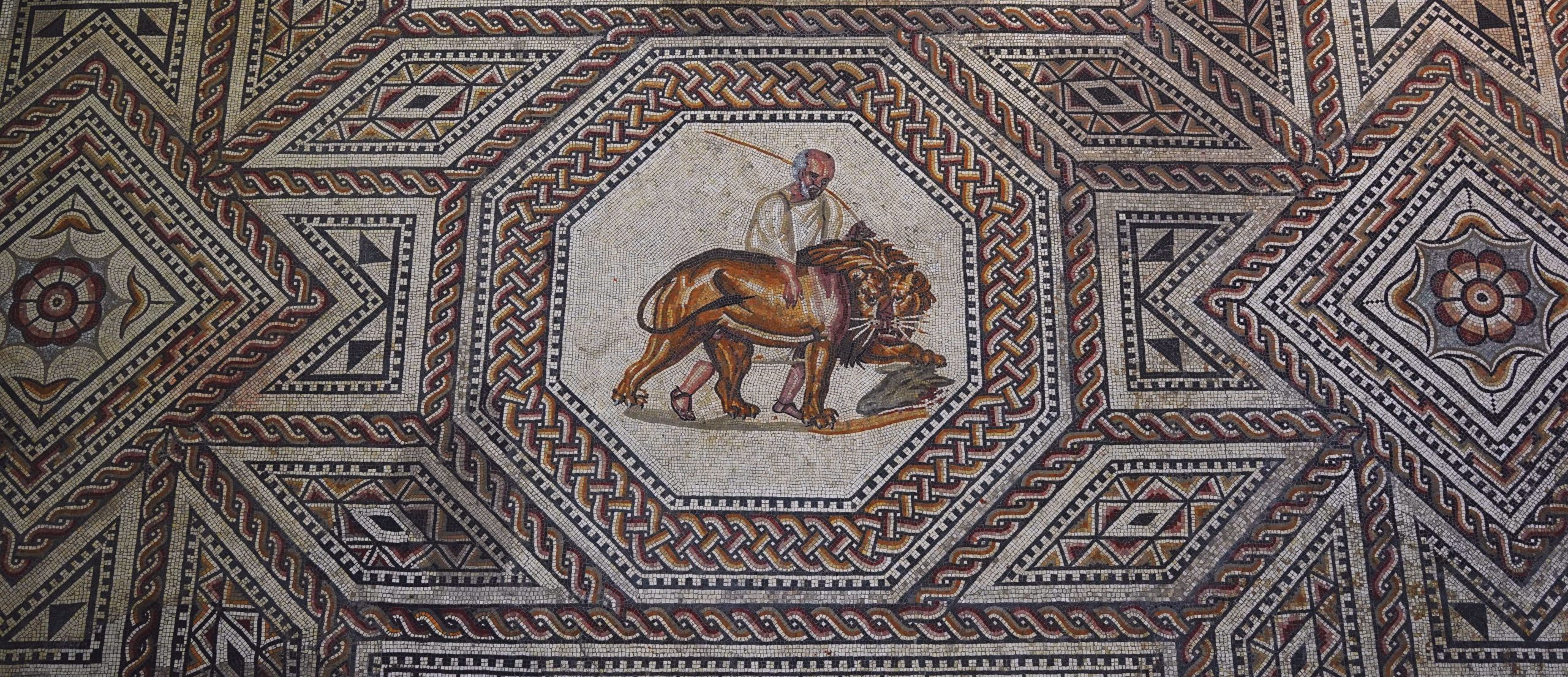The Villa of Nennig was discovered by chance in 1852: its discovery is due to a peasant digging a pit in his garden intended for the conservation of vegetables. The Archaeological Society of Treves, warned of the find of Roman remains, hastened to acquire the land and erected a temporary protective construction. The ruins of the villa are noted for their exceptional mosaics, which have survived in remarkably good condition. They are considered as one of the most important of its kind north of Alps and they include vivid depictions of gladiators fighting.
Splendid Villa of Nennig
According to evidence of various finds (coins, fibulae, ceramics), the Villa of Nennig was founded in the 1st century AD. The Villa was divided into a living area (Pars urbana) and an economic area (Pars rustica). The latter consisted of a courtyard through which a paved road lead from the Moselle river to the manor house. Utility and residential buildings stood on both sides of the courtyard.
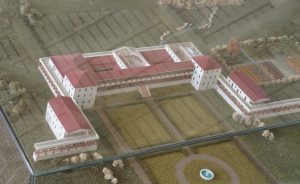
Source of the picture: TimeTravelRome. Licence: CC BY 2.0. Full album: See more on Flickr.
The Pars urbana of the villa included a residential building 120 m wide with a portico facade, two spacious side wings (guest apartments) connected to the main building by porticos, a vast 500 m² large bathhouse and an 260 m long Garden portico between the main house and the Baths. It was certainly a splendid residence, one of the most beautiful and luxury in the region. The villa was likely abandoned by the end of the fourth century.
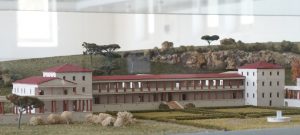
Source of the picture: TimeTravelRome. Licence: CC BY 2.0. Full album: See more on Flickr.
Today visitors can see the foundation walls of the manor house, and parts of the peristyle north of the mosaic room.
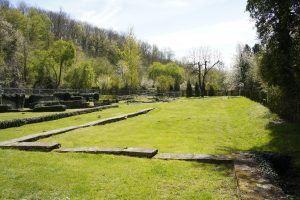
Source of the picture: TimeTravelRome. Licence: CC BY 2.0. Full album: See more on Flickr.
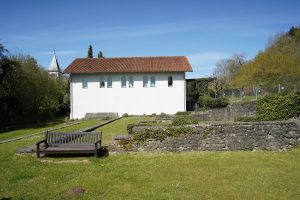
Source of the picture: TimeTravelRome. Licence: CC BY 2.0. Full album: See more on Flickr.
Gladiatorial Mosaic
The Villa of Nennig is famous for the excellent 15.65 x 10.30 m mosaic in the reception room of the manor house. The mosaic is considered as one of the finest and most important examples of Roman mosaic art from the 2nd and 3rd centuries AD north of the Alps, and it is one of the few to remain in its place of origin.
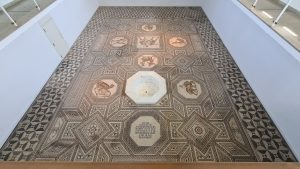
Source of the picture: TimeTravelRome. Licence: CC BY 2.0. Full album: See more on Flickr.
Seven of the original eight medallions of the Mosaic have survived. The eights medallion at the entrance has been destroyed, perhaps intentionally, by later occupants of the villa. In its place is a modern inscription indicating that the mosaic was discovered in 1852, reconstructed in 1874, and completely restored in 1960, when the mosaic was reset on pillars to protect it from ground water.
What the Mosaic Shows ?
The mosaic depicts scenes from the circus: medallions tell a bloody story of the cruel games taking place in the amphitheater.
1/ A Retiarus armed with trident and dagger is fighting against a Secutor. The first character on this medallion is armed with a three-pointed spear called tridens or fuscitia. This gladiator – a Retiarus – from the name of a net, “rete”, has the head encircled by a sort of crown, lemniscus. This crown was a mark of distinction indicating that the wearer had been victorious several times. The character on the right, a Secutor, is armed with a helmet and a large shield. Behind them and in the middle, there is a lanista, or master of gladiators, who seems to stimulate them by his gestures.
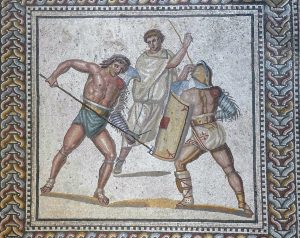
Source of the picture: TimeTravelRome. Licence: CC BY 2.0. Full album: See more on Flickr.
2/ In this scene, which is in the center of the mosaic, a bear has thrown one of the gladiators to the ground, while two confederates try to drive the animal off by lashes from their whips.
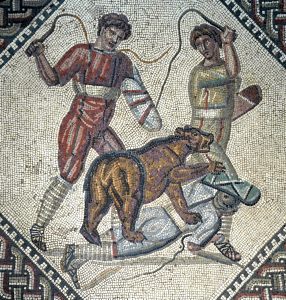
Source of the picture: TimeTravelRome. Licence: CC BY 2.0. Full album: See more on Flickr.
3/ This medallion was the first to be discovered (in 1853). It depicts a lion, with only the head of the ass still is in his possession, being led away by his aged keeper.
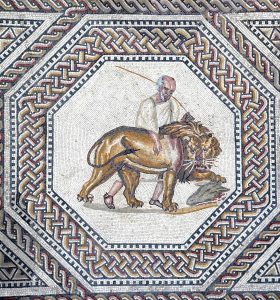
Source of the picture: TimeTravelRome. Licence: CC BY 2.0. Full album: See more on Flickr.
4/ Venator with leopard. Wounded, the leopard tries to pull the javelin out of its side but succeeds only in breaking it off. The venator, his left arm protected and another spear in his hand, acknowledges the acclamation of the crowd.
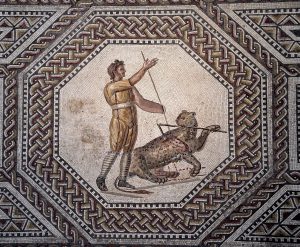
Source of the picture: TimeTravelRome. Licence: CC BY 2.0. Full album: See more on Flickr.
5/ The beginning and conclusion of the games would be announced by music, often including a water organ (hydraulis), in which water pressure pushed the air through the bronze pipes. The mosaic of Nennig depicts an organist and a horn (cornu) player. The organ is shown in details: it has a hexagonal water cistern set on a plinth with cylinder pumps mounted on each side towards the top of the cistern. The wind chest is also hexagonal and rests on the cistern and rising from it are twenty eight pipes, with the longest, base pipes on the organist’s right.
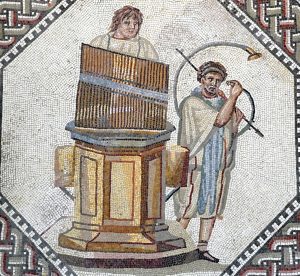
Source of the picture: TimeTravelRome. Licence: CC BY 2.0. Full album: See more on Flickr.
6/ Two combatants are attacking one another with cudgels and a whip.
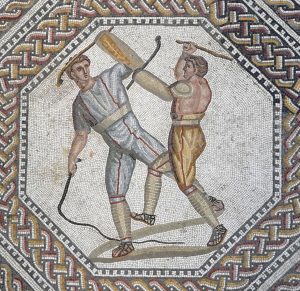
Source of the picture: TimeTravelRome. Licence: CC BY 2.0. Full album: See more on Flickr.
7/ A female tiger has brought down a wild ass and looks about before beginning her feast.
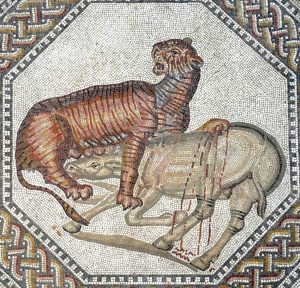
Source of the picture: TimeTravelRome. Licence: CC BY 2.0. Full album: See more on Flickr.
The design of the framing ornament is very beautiful and a rich.
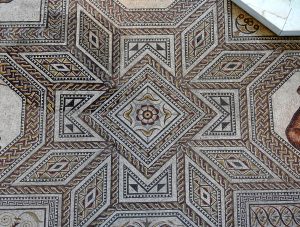
Source of the picture: TimeTravelRome. Licence: CC BY 2.0. Full album: See more on Flickr.
Roman Tumulus of Nennig
Between the Villa’s Baths and the Moselle river a burial mound (tumulus or Mahlknopf) was erected on the domain. Excavations conducted in 1986/87 allowed the discovery of a circular wall at the foot of the Tumulus with a diameter of 44.5 m. The tomb was surrounded by a square wall measuring 94 x 100 m. It is possible that the burial mound was modeled on the tomb of Emperor Augustus in Rome, underlining the prosperity and the prominent social position of the former owner of the villa.
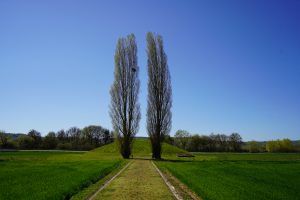
Source of the picture: TimeTravelRome. Licence: CC BY 2.0. Full album: See more on Flickr.
Nennig Villa on TimeTravelRome
The villa is featured in our Mobile App together with other Roman remains around the Trier.
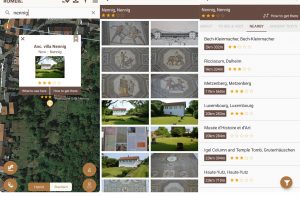
Sources:
« Une visite à la mosaique de Nennig », Georges Boulangé, Revue Archéologique, 1855, No. 1, pp. 106-112. https://www.jstor.org/stable/41742211
« Musical Instruments in the Roman World », Thesis by Mary Angela Wardle, University of London, Institute of Archaeology, September 1981. Vol 2. https://discovery.ucl.ac.uk/id/eprint/1317908/2/299235_Vol2.pdf
Nice article about the Mosaic (I kindly borrowed a few elements used for mosaics description): https://penelope.uchicago.edu/~grout/encyclopaedia_romana/gladiators/nennig.html
